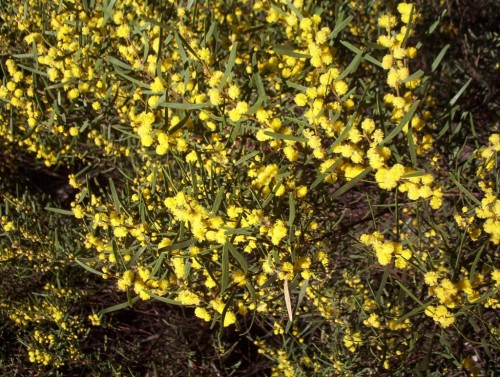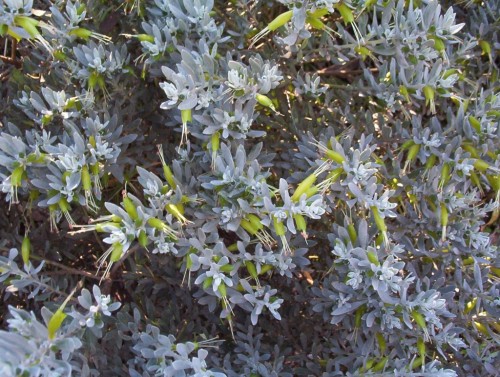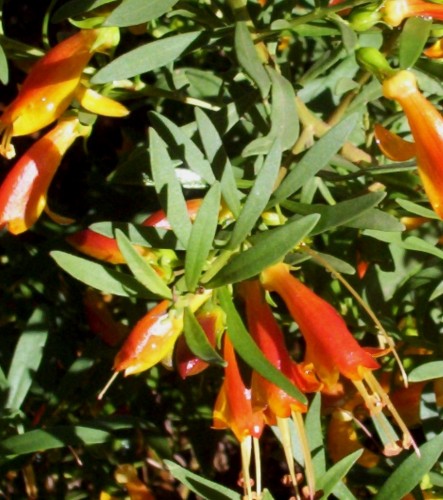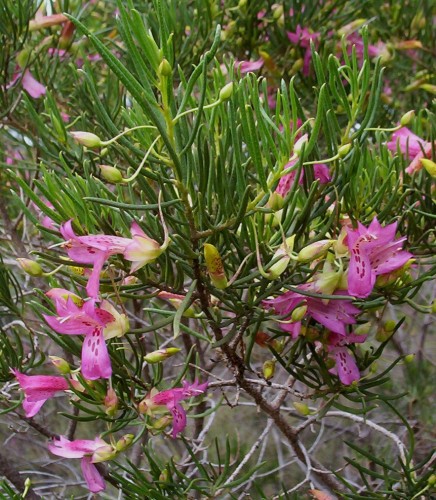Eremophila complanata
Eremophila complanata is another of those tough lime and drought tolerant plants. It is in full flower at the moment making a lovely splash of colour.
Before using Australian Natives as cut flowers became more widely practised, we knew that this one kept for two weeks in a vase. It is still not on any published lists of plants suitable for the cut flower trade.
When our local group of the Australian Plant Society used to organise a Spring Flower Show we got to know how many species behaved when cut for display.
Eremophila complanata is a shrub to about one and a half metres, by nearly a metre wide. It would be a bit smaller if I took cuts from the bush regularly. It becomes straggly if not trimmed after flowering.
Acacia wilhelmmiana
ITWhiz Son is messing around with the layout of my blog. I like the photo grouping across the top but may get him to put a couple of different ones on that better reflect the types of plants that I like to propagate.
The warm wind today will finish off the wattles here I think. Acacia notabilis (Notable Wattle) had a few isolated golden balls as opposed to the masses of flowers in previous years. Acacia wilhelmiana was looking quite good but is going ‘off’ now.
This grows along the roadsides here. They are a wide shrub, perhaps 3-4m by about 2m tall. They create a hedge like effect and would be great for that hedge or screening effect, especially in wind break plantings. As always, drought tolerant, frost hardy and lime tolerant.
Many people complain that wattles cause allergic reactions etc yet it is denied that these are the culprits. Many grasses cause hayfever and most flower when the wattles are also in flower.
I love the cheery colours as they begin flowering when it is still dull and grey here.
Eremophila glabra ‘Brice’
Eremophila glabra ‘Brice’ is one of the most attractive Eremophilas. It has masses of lime green flowers on blue green foliage. The plants are abour 30cm tall by about 80 cm across. They do not appear to like acidic soil as I found out when my potting mix became too acid. The leaves took on a burnt appearance on the tips. When I watered the pots with water containing agricultural lime, the problem was gradually corrected.
There are a number of Eremophila glabra forms. All need good drainage and do best in full sun. They will grow quite well with part of the day in dappled shade.
Hardy Eremophilas
I was collecting cuttings of Eremophilas (Emu Bushes) today and realised I had quite a good collection of species, with lots still to collect. I read constantly that those folk who are in drought affected areas have found that Eremophilas are the plants that survive when others have just not coped with the lack of rain or inability to water with hoses. I have also discovered in the nursery, that the pots that are on the edge of the watering system do much better than those being more heavily watered.
Hardy is a relative word. These are hardy here in the dry mallee areas of South Australia. In general, Eremophilas need good drainage and a sunny warm position. Many prefer heavier soils as opposed to sand.
Here is a list of some of my hardy plants.
- Eremophila glabra sub species (ssp) carnosa
- Eremophila glabra ‘Roseworthy’
- Eremophila glabra prostrate form with grey leaves and red flowers.
- Eremophila glabra ‘Brice’
- Eremophila divaricata
- Eremophila densifolia
- Eremophila divaricata x polyclada
- Eremophila subteretifolia
- Eremophila nivea
- Eremophila maculata various colour forms
- Eremophila youngii
- Eremophila drummondii
- Eremophila veneta
- Eremophila weldii
Eremophila alternifolia (Narrow-leaf Fuchsia Bush)
I was thinking about drought tolerant plants while collecting cuttings and taking photos this morning. It’s amazing how hardy some plants are. There is not a drop of moisture in the subsoil after a very dry winter.
Some Eremophilas are flowering. They are the plants that will survive the driest conditions. They need to be pruned to prevent straggly growth, or the leaves being above your head while you look at bare woody branches. Some can be chopped back to the stump and will sprout prolifically. Many prefer quite heavy soil, so long as the drainage is good. Eremophila alternifolia is one of these. This one needs to be tip prune regularly to maintain a neat bush.




